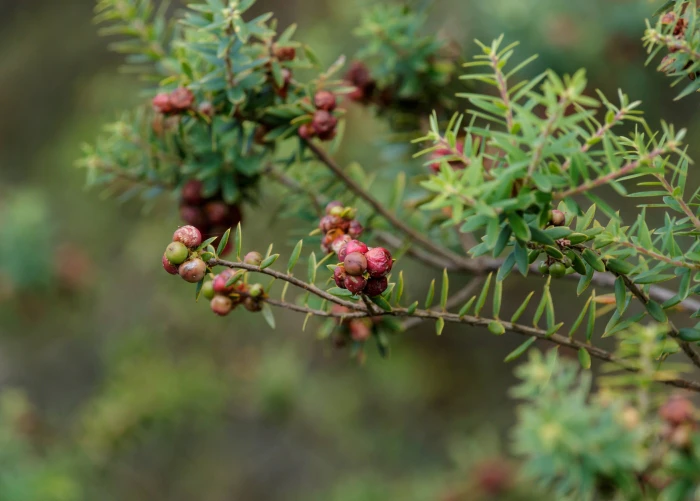Pūkiawe
(Leptecophylla tameiameiae)
Pūkiawe (Leptecophylla tameiameiae)
/
/

© Meghan Cassidy
CC BY-SA 4.0
Image By:
© Meghan Cassidy
Recorded By:
Copyright:
CC BY-SA 4.0
Copyright Notice:
Photo by: © Meghan Cassidy | License Type: CC BY-SA 4.0 | License URL: http://creativecommons.org/licenses/by-sa/4.0/ | Uploader: wildcarrot | Publisher: iNaturalist |






















Estimated Native Range
Climate Requirements for Whittier, California
| This Plant | Your Site | Plant Suitability for Your Location | ||
|---|---|---|---|---|
| • Precipitation | 25" - 187" | 17" | Your precipitation may be insufficient for this plant. Irrigate N" / year. | Irrigate N" / year |
| • High Temp. | 52°F - 89°F | 88°F | Your summer temperatures are normal for this plant. | Excellent |
| • Low Temp. | 16°F - 67°F | 44°F | Your winter temperatures are normal for this plant | Excellent |
This plant should grow well at your location with about N inches per year (Y minutes per month) of irrigation.
Summary
Leptecophylla tameiameiae, commonly known as pūkiawe or maiele, is a shrub or small tree endemic to the Hawaiian and Marquesas Islands. It can reach up to 15 feet in height and is characterized by its small needle-like leaves. The plant produces berries that can vary in color from white to pink to red, which are often used in traditional Hawaiian leis. Pūkiawe is found in a diverse range of elevations from 49 to 10,597 feet, typically in subalpine shrublands and bogs, as well as mixed mesic and wet forests. It is a versatile and resilient species, able to adapt to various environmental conditions within its native range.
Pūkiawe is valued for its cultural significance and is used in traditional Hawaiian medicine. The leaves have been used to treat congestion, and the fruit is incorporated into leis. Historically, the smoke from burning pūkiawe wood was believed by Hawaiian nobility to alter spiritual energy or mana, and it was used in the cremation of criminals to render their spirits harmless. In cultivation, pūkiawe is appreciated for its hardiness and adaptability, making it suitable for a variety of landscape uses, including naturalistic plantings and restoration projects. It thrives in well-drained soils and can tolerate a range of light conditions, from full sun to partial shade. While it is not commonly afflicted by serious diseases or pests, it is important to avoid overwatering to prevent root rot. Pūkiawe is not known for aggressive roots or invasiveness.CC BY-SA 4.0
Pūkiawe is valued for its cultural significance and is used in traditional Hawaiian medicine. The leaves have been used to treat congestion, and the fruit is incorporated into leis. Historically, the smoke from burning pūkiawe wood was believed by Hawaiian nobility to alter spiritual energy or mana, and it was used in the cremation of criminals to render their spirits harmless. In cultivation, pūkiawe is appreciated for its hardiness and adaptability, making it suitable for a variety of landscape uses, including naturalistic plantings and restoration projects. It thrives in well-drained soils and can tolerate a range of light conditions, from full sun to partial shade. While it is not commonly afflicted by serious diseases or pests, it is important to avoid overwatering to prevent root rot. Pūkiawe is not known for aggressive roots or invasiveness.CC BY-SA 4.0
Plant Description
- Plant Type: Shrub
- Height: 3-15 feet
- Width: 6-8.25 feet
- Growth Rate: Moderate
- Flower Color: White, Pink
- Flowering Season: Fall, Winter
- Leaf Retention: Evergreen
Growth Requirements
- Sun: Full Sun, Part Shade
- Water: Medium
- Drainage: Medium, Fast
Common Uses
Bird Garden, Border Plant, Butterfly Garden, Drought Tolerant, Low Maintenance
Natural Habitat
Endemic to subalpine shrublands, bogs, mixed mesic forests, and wet forests within the Hawaiian and Marquesas Islands
Other Names
Common Names: Pukia
Scientific Names: Leptecophylla tameiameiae, Cyathodes banksii, Cyathodes douglasii, Cyathodes douglasii subsp. struthioloides, Cyathodes douglasii var. struthioloides, Cyathodes imbricata, Cyathodes imbricata subsp. struthioloides, Cyathodes imbricata subsp. volcanica, Cyathodes imbricata var. struthioloides
GBIF Accepted Name: Leptecophylla tameiameiae